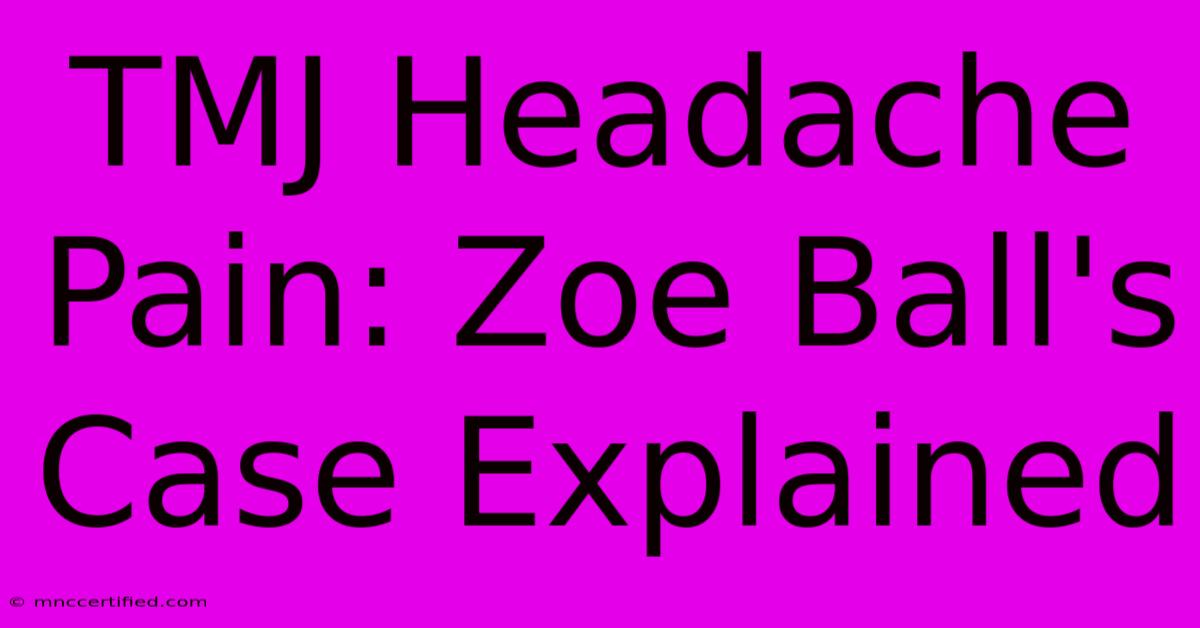TMJ Headache Pain: Zoe Ball's Case Explained

Table of Contents
TMJ Headache Pain: Zoe Ball's Case Explained
Tempero-mandibular joint (TMJ) disorders are a common cause of headache pain, and understanding them is crucial for effective treatment. This article will explore the connection between TMJ and headaches, using the well-known case of broadcaster Zoe Ball as a relatable example. We'll examine the symptoms, causes, diagnosis, and treatment options available for those suffering from TMJ-related headaches.
Understanding TMJ and its Link to Headaches
The temporomandibular joint (TMJ) connects your jaw to your skull. When this joint is damaged or dysfunctional, it can lead to a variety of symptoms, including severe headaches. These headaches are often described as tension headaches, but can also manifest as migraines in some individuals. The pain isn't limited to the jaw; it can radiate to the temples, forehead, and even the neck and shoulders.
Zoe Ball's Experience: A Public Case Study
While Zoe Ball hasn't explicitly detailed the specifics of her TMJ diagnosis and treatment, public statements and interviews hint at the challenges she faced with chronic jaw pain and associated headaches. This highlights the prevalence of TMJ disorders and their significant impact on daily life. Her experience, while not a clinical case study, serves as a relatable example for many suffering in silence.
Common Symptoms of TMJ-Related Headaches
Recognizing the symptoms is the first step in seeking treatment. Symptoms can vary in intensity and frequency, but common indicators include:
- Headaches: Often localized to the temples or forehead, but can be more widespread.
- Jaw pain: Pain in the jaw joint itself, often worsening with chewing or yawning.
- Facial pain: Pain in the face, particularly around the cheeks and temples.
- Neck pain: Stiffness and pain in the neck muscles.
- Earaches: Pain in or around the ear, sometimes accompanied by tinnitus (ringing in the ears).
- Clicking or popping sounds: Noises emanating from the jaw joint during movement.
- Limited jaw movement: Difficulty opening or closing the mouth fully.
- Facial asymmetry: One side of the face may appear slightly different than the other.
Causes of TMJ Disorders and Headaches
Several factors can contribute to the development of TMJ disorders and subsequent headaches:
- Bruxism (teeth grinding): This common habit puts significant stress on the jaw joint.
- Stress and anxiety: Increased stress levels can exacerbate TMJ symptoms.
- Arthritis: Degenerative joint diseases like osteoarthritis can affect the TMJ.
- Injury: Trauma to the jaw or face can damage the joint.
- Poor posture: Maintaining poor posture can strain the jaw muscles and the TMJ.
- Genetics: A family history of TMJ disorders can increase the risk.
Diagnosis and Treatment of TMJ-Related Headaches
Diagnosing TMJ disorders involves a thorough examination by a dentist, physician, or specialist. This may include:
- Physical examination: Assessing jaw range of motion, palpation of the jaw joint, and evaluating muscle tension.
- Imaging tests: X-rays, CT scans, or MRIs may be used to visualize the joint and surrounding structures.
- Review of symptoms: A detailed account of the patient's symptoms is crucial.
Treatment options vary depending on the severity of the condition and may include:
- Lifestyle modifications: Stress management techniques, improved posture, and avoiding jaw-straining activities.
- Medications: Pain relievers, muscle relaxants, and anti-inflammatory drugs.
- Physical therapy: Exercises to improve jaw muscle strength and range of motion.
- Splints or mouthguards: Devices worn at night to prevent teeth grinding and protect the TMJ.
- Injections: Corticosteroid injections can help reduce inflammation.
- Surgery: In severe cases, surgery may be necessary to correct structural abnormalities.
Seeking Professional Help: When to Consult a Doctor
If you are experiencing persistent headaches, jaw pain, or other TMJ-related symptoms, it's essential to consult a healthcare professional. Early diagnosis and treatment can significantly improve your prognosis and prevent long-term complications. Don't suffer in silence – seek help to regain your quality of life.
Keywords:
TMJ, Temporomandibular Joint Disorder, TMJ headache, headache pain, jaw pain, Zoe Ball, bruxism, teeth grinding, migraine, tension headache, facial pain, neck pain, earache, jaw clicking, limited jaw movement, TMJ treatment, TMJ diagnosis, TMJ causes, TMJ symptoms.
Off-Page SEO Considerations:
- Link building: Collaborate with relevant websites and healthcare professionals to build high-quality backlinks to this article.
- Social media promotion: Share the article on relevant social media platforms to increase visibility.
- Guest blogging: Contribute articles to other health and wellness websites to reach a wider audience.
- Forum participation: Engage in online forums related to TMJ and headaches to build authority and establish your expertise.
This article provides comprehensive information on TMJ-related headaches and uses Zoe Ball's case as a relatable example to increase reader engagement and understanding. Remember, this information is for educational purposes only and should not be considered medical advice. Always consult with a qualified healthcare professional for diagnosis and treatment.

Thank you for visiting our website wich cover about TMJ Headache Pain: Zoe Ball's Case Explained. We hope the information provided has been useful to you. Feel free to contact us if you have any questions or need further assistance. See you next time and dont miss to bookmark.
Featured Posts
-
Comdex Life Insurance Ratings
Nov 29, 2024
-
Foremost Rv Insurance Reviews
Nov 29, 2024
-
Starbucks Hours Thanksgiving Day
Nov 29, 2024
-
Lions Game Montgomery St Brown In
Nov 29, 2024
-
Cold Weather Payment 10 000 Get Funds Update
Nov 29, 2024